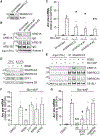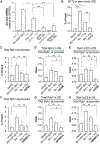Activity-assembled nBAF complex mediates rapid immediate early gene transcription by regulating RNA polymerase II productive elongation
- PMID: 39412992
- PMCID: PMC11625021
- DOI: 10.1016/j.celrep.2024.114877
Activity-assembled nBAF complex mediates rapid immediate early gene transcription by regulating RNA polymerase II productive elongation
Abstract
Signal-dependent RNA polymerase II (RNA Pol II) productive elongation is an integral component of gene transcription, including that of immediate early genes (IEGs) induced by neuronal activity. However, it remains unclear how productively elongating RNA Pol II overcomes nucleosomal barriers. Using RNAi, three degraders, and several small-molecule inhibitors, we show that the mammalian switch/sucrose non-fermentable (SWI/SNF) complex of neurons (neuronal BRG1/BRM-associated factor or nBAF) is required for activity-induced transcription of neuronal IEGs, including Arc. The nBAF complex facilitates promoter-proximal RNA Pol II pausing and signal-dependent RNA Pol II recruitment (loading) and, importantly, mediates productive elongation in the gene body via interaction with the elongation complex and elongation-competent RNA Pol II. Mechanistically, RNA Pol II elongation is mediated by activity-induced nBAF assembly (especially ARID1A recruitment) and its ATPase activity. Together, our data demonstrate that the nBAF complex regulates several aspects of RNA Pol II transcription and reveal mechanisms underlying activity-induced RNA Pol II elongation. These findings may offer insights into human maladies etiologically associated with mutational interdiction of BAF functions.
Keywords: Arc; BD98; CP: Molecular biology; CP: Neuroscience; RNA Pol II; RNA polymerase II; SWI/SNF; immediate early gene; nBAF; neuron; productive elongation; transcription.
Copyright © 2024 The Author(s). Published by Elsevier Inc. All rights reserved.
Conflict of interest statement
Declaration of interests The authors declare no competing interests.
Figures







Update of
-
Activity-assembled nBAF complex mediates rapid immediate early gene transcription by regulating RNA Polymerase II productive elongation.bioRxiv [Preprint]. 2023 Dec 30:2023.12.30.573688. doi: 10.1101/2023.12.30.573688. bioRxiv. 2023. Update in: Cell Rep. 2024 Nov 26;43(11):114877. doi: 10.1016/j.celrep.2024.114877. PMID: 38234780 Free PMC article. Updated. Preprint.
References
Publication types
MeSH terms
Substances
Grants and funding
LinkOut - more resources
Full Text Sources
Miscellaneous

